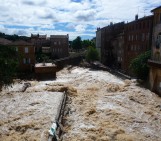
This photograph shows El salto del Tequendama, a natural waterfall of Colombia, located in the Department of Cundinamarca at an altitude of 2400 metres above sea level and approximately 30 kilometres southwest of the country’s capital, Bogotá.
The Salto del Tequendama is a space of transit and connectivity between the warm lands of the Magdalena river basin and the cold lands of the Sumapaz paramo, a Neotropical alpine tundra located at 4,000 metres above sea level.
Dutch-Colombian geologist Thomas Van der Hammen concluded that approximately 60,000 years ago the entire savannah of Bogota (populated today by 9 million people) was covered by a large lake, known as the Humboldt Lake, and the associated wetland plants instead of the paramo vegetation seen today.
Over time, the climate became warmer and the bottom of the Humboldt Lake began to rise. 30,000 years ago, the lake’s waters were channelled through the Bogota River and led to the Salto del Tequendama, a real climate event that we Colombians received through the myth of Bochica, a legendary hero to the Colombian indigenous group the Muisca. Here is the summarised myth of Bochica and the Tequendama jump:
“… As the Muiscas had lost respect for the gods, they offended Chibchacum, who had previously been the most beloved of their gods. He decided to punish them by flooding the savanna, for which he gave birth to the Sopo and Tivito rivers, which joined their rivers to the Funza (former name of the Bogotá River). The flood ended with many crops and human lives, until the people clamored with fasting and sacrifices to Bochica to free them from that calamity. The sage Bochica appeared on the rainbow and with his golden scepter, hit the rocks allowing the water to form a gigantic waterfall. So Bochica created the Tequendama jump.”
The large lake was partially dried and separated into smaller wetlands, where Andean plants, deer, foxes, weasels and more than 100 bird species made their home.
The waterfall, famous for its size, surrounding vegetation and vapourous waters, has been widely studied since 1668, when the Bishop of Panamá, Lucas Fernández de Piedrahíta made the first written record of its mythical origin story.
During the 18th and 19th centuries in particular, the Salto was one of the most famous natural attractions both locally and worldwide, due to the waterfall’s 157-metre drop onto a circular rocky abyss in a wooded region of permanent haze.
In the 19th century, large estates, also known as haciendas, were built on the region’s wetlands, and the natural environment was converted into places for fishing, hunting and logging. Through drainage channels, communities dried up the land to establish livestock and agricultural systems. In the last century, as the city of Bogota grew in population and size, the wetlands were filled to build neighborhoods, streets and avenues.
Like many Bogotanos, on a family weekend trip to relieve the stress generated by the chaos of the city and in search of clean air, I took this picture. The Salto was and always has been a fundamental part of the Bogota family mythology.
By Maria Cristina Arenas Bautista, National University of Colombia, Department of Civil Engineering and Agricultural (Bogotá)
Imaggeo is the EGU’s online open access geosciences image repository. All geoscientists (and others) can submit their photographs and videos to this repository and, since it is open access, these images can be used for free by scientists for their presentations or publications, by educators and the general public, and some images can even be used freely for commercial purposes. Photographers also retain full rights of use, as Imaggeo images are licensed and distributed by the EGU under a Creative Commons licence. Submit your photos at http://imaggeo.egu.eu/upload/.




Syam Trekker
Great posting about A Colombian myth with geologic origins and beautiful picture , thank you for sharing